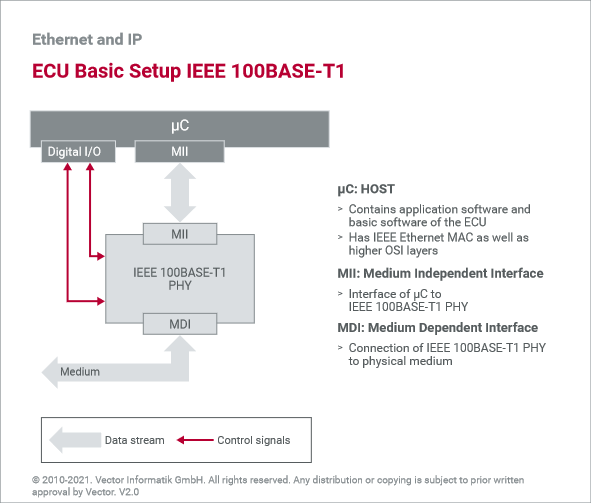IEEE 100BASE-T1 (formerly OABR)
Standard
OABR (Open Alliance BroadR-Reach) is a physical transmission technology that was originally developed by Broadcom and standardized as IEEE 100BASE-T1. The transformation into an IEEE standard was done by the Open Alliance SIG.

Physical connection
A twisted pair cable on which symmetrical differential voltages are applied is used for the physical connection. The voltages represent symbols that a sender encodes based on the desired bit stream. A receiver uses the resulting symbol stream in turn to decode the contained bits.

Encoding and decoding
A combination of 4B3B, 3B2T, and PAM3 methods are used for the encoding and decoding and for generation of the differential voltages. These methods are implemented in the IEEE 100BASE-T1 PHY, which is integrated as a dedicated block in the ECU. The PHY establishes the connection between the physical medium and Ethernet controller.

Topology
Only two nodes are ever connected to one cable. Thus, only point-to-point connection topology is available. More than two nodes can be connected using a coupling element. A switch is normally used here, which as a Layer 2 coupling element allows connection to multiple physical connections and can independently forward messages from branch to branch.
Full duplex
An especially appealing aspect of this physical layer is that information can be transferred bidirectionally on a wire pair at 100 Mbit/s. Two interconnected nodes can send and receive simultaneously (full duplex). As a sender, a node adds its own differential voltage to the two wires; while as a receiver, it subtracts its own voltage from the applied total voltage. The result of the subtraction corresponds to the voltage that was sent by the opposite node. This mechanism is a component of the echo cancellation method that is used in other Ethernet systems.
Synchronization
In order for differential voltages to be added or subtracted, the two nodes must know when a new symbol begins. This means that both nodes must be synchronized to the symbol stream. This is done with the help of a master node and slave node. The master generates a continuous symbol stream to which the slave is synchronized. The basic software of the microcontroller configures the PHY as a master or slave.
